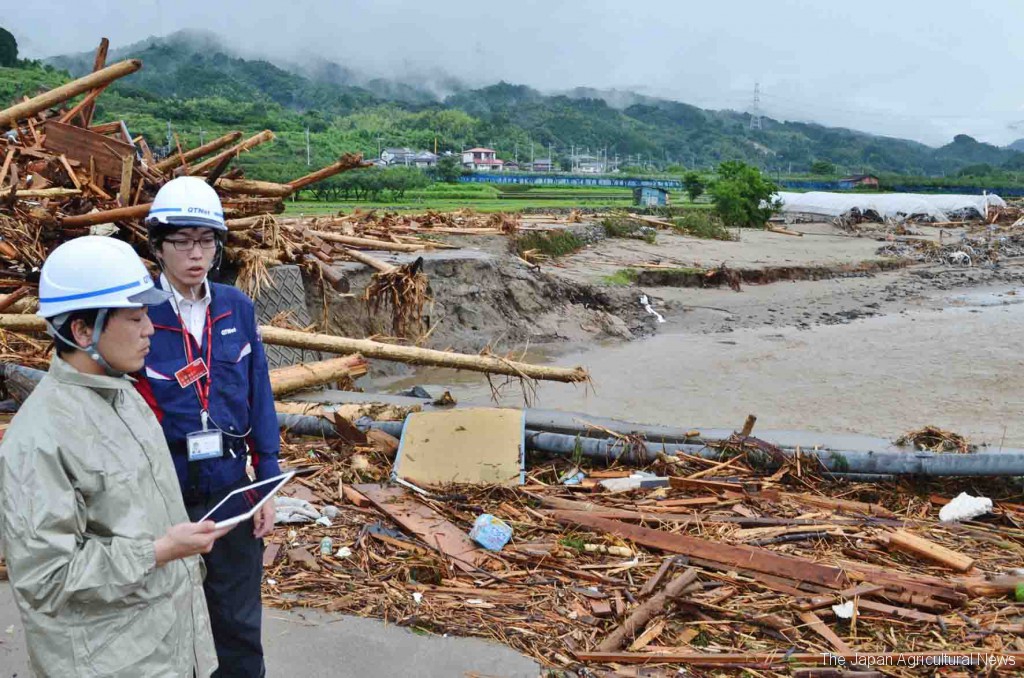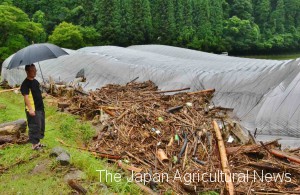
Akaya River flooded into rice fields and greenhouses. Greenhouses for strawberries (right in the back) were destroyed. (in Asakura, Fukuoka Prefecture)
Fukuoka and Oita, July 7 ― Torrential rain destroyed the northern part of Kyushu on July 5 and 6, 2017, causing flood and mudslides. Some people were confirmed dead and many others missing. In Asakura, Fukuoka Prefecture, and Hita, Oita Prefecture, people saw record-high precipitation, and farmers suffered very severe damage on their fields and greenhouses in the floods and the mudslides. Local agricultural cooperatives and other entities are urging to obtain concrete information, but it’s been still difficult to have the full picture of the damage.
Damage of unprecedented level (in Asakura, Fukuoka Prefecture)
“The landscape is totally different, and we are left with no recovery in sight.” It was around two o’clock in the afternoon on July 6. A 51-year-old persimmon farmer barely escaped from his home in Haki, Asakura, Fukuoka Prefecture. The first floor of the house and his car were almost entirely covered by mud.
Later, he confirmed landslides in the persimmon mountain close to his home. However, there is still no way for him to confirm what his 3-hector persimmon plantation is like. “This is far beyond the torrential rain that hit the northern part of Kyushu five years ago. I must say, it was lucky that I survived.”
According to a 55-year-old farmer who grows grapes in his 10-are greenhouses, “there were rivers in the places where there weren’t any river.” He is shocked at the damage of unprecedented level. His grapes did not suffer severe damage, but he still worries about root rot and prevalence of plant diseases after the floods.
A fruit sorting area of a local agricultural cooperative, JA Chikuzen Asakura Haki, was also covered by mud and muddy water. JA employees struggled to get rid of the dirt to restart the operation. Machines there could have become out of order if soaked in muddy water. The JA had been preparing for the shipment of plums, and the sorting of grapes was to begin on July 6.

A greenhouse with a lot of driftwood sticking out. The owner replaced the ceiling in mid-June. (in Hita, Oita Prefecture)
“Why now?” (in Hita, Oita Prefecture)
In Hita, Oita Prefecture, rivers flooded, pushing mud into agricultural fields and later leaving a vending machine lying in a rice paddy, driftwood sticking out of bridge rails, and river fish left in the fields. Greenhouses were squashed by water, and qing-geng-cai inside the plastic houses was damaged.
At two o’clock in the afternoon on July 6, there were three half-destroyed greenhouses along the Prefectural road covered by driftwood and mud. The central parts of all the three houses bend down to touch the ground. A number of driftwood was sticking out of the plastic wall of one of the greenhouses.
The owner, aged 52, recalled the day and said, “My house was entirely surrounded by water. It could be washed away anytime.” That night, he slept only 30 minutes as he was trying to keep himself up and ready to escape with his old parents anytime when water flows in.
His greenhouses were flooded when the heavy rainfall hit northern Kyushu five years ago. It was the time his parents were growing asparagus, but due to massive reductions in yields, they decided to give up the business. After two years of interval, the family stood up again to restart, and in June this year, they put new ceilings for the once-devastated greenhouses.
“We were just about to overcome the damage from the deluge five years ago. Why now?” he said, biting hard on his lip.

